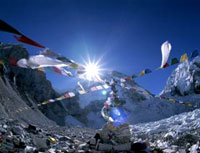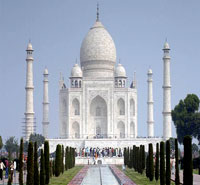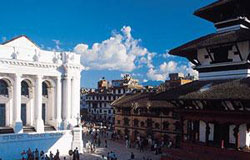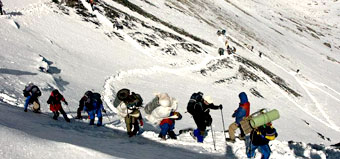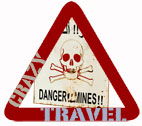UPPER MUSTANG

Mustang, opened to foreigners in 1992, is by far Nepal's most restricted trekking area. It is located in the Northwestern area of Nepal, and is part of the Tibetan plateau.
This area has long been inhabited by Tibetan Buddhists and such rich, untouched culture is found here. Trekkers are not common here which is why this trek provides such a rare and up close
This area has long been inhabited by Tibetan Buddhists and such rich, untouched culture is found here. Trekkers are not common here which is why this trek provides such a rare and up close
look at a society that has remained unaffected by change for centuries. Unfortunately there is a high price to pay for such an experience. Permits are $500 per person for 10 days and $50 per day thereafter. The starting and ending point for all treks in the Mustang region is Jomsom, which can only be reached by plane. Trekking in Mustang is truly one of the rarest and most rewarding experiences to be had in Nepal.
Best Season: Sept to Nov, Mar to May
Type of Trek: Camping Max Altitude: 4050m
Minimum Pax: 2 +
Duration: 20 Days
Itinerary of Kathmandu, Pokhara and Upper Mustang
Day 1: Arrive At Kathmandu International Airport and transfer to the Hotel
Kathmandu is the capital city of Nepal. It is said before Kathmandu used to be a lake. A goddess name Manjushree with her sword cut one part of hill in a place called Chobar and since then people started to live. Welcome Drinks with Briefing about the Tour Rest of the day is free for Individual Activities/ Shopping/ Casino
over Night atHotel.
Day 2: After breakfast full day Kathmandu sightseeing by private vehicle
Swayambhunath, situated on a hillock about 77m above the level of the Kathmandu Valley is one of the worlds most glorious Buddhist Chaityas, said to be 2000 years old. Swayambhnath is located 4 km west of central Kathmandu.
Best Season: Sept to Nov, Mar to May
Type of Trek: Camping Max Altitude: 4050m
Minimum Pax: 2 +
Duration: 20 Days
Itinerary of Kathmandu, Pokhara and Upper Mustang
Day 1: Arrive At Kathmandu International Airport and transfer to the Hotel
Kathmandu is the capital city of Nepal. It is said before Kathmandu used to be a lake. A goddess name Manjushree with her sword cut one part of hill in a place called Chobar and since then people started to live. Welcome Drinks with Briefing about the Tour Rest of the day is free for Individual Activities/ Shopping/ Casino
over Night atHotel.
Day 2: After breakfast full day Kathmandu sightseeing by private vehicle
Swayambhunath, situated on a hillock about 77m above the level of the Kathmandu Valley is one of the worlds most glorious Buddhist Chaityas, said to be 2000 years old. Swayambhnath is located 4 km west of central Kathmandu.

The Pashupatinath Temple in Kathmandu is a temple of Lord Shiva, with two tiered golden roof and silver doors, is famous for its superb architecture. It is situated 5km east of Kathmandu city. This temple is regarded as one of the holiest sites for Hindus all over the world. Visitors can clearly seen the temple and the activities performed in the temple premises from the eastern bank of the Bagmati river.
The stupa of Bouddhnath is an ancient Buddhist monument and is the biggest stupa in Nepal. It is located 5km east of central Kathmandu.
The stupa of Bouddhnath is an ancient Buddhist monument and is the biggest stupa in Nepal. It is located 5km east of central Kathmandu.
The stupa stands on a three-tiered platform raised over the crossed rectangles. Every Buddhist come to visit Boudhanath for making round the stupa. Buddhist believes Boudha Stupa is the mind of Buddha.
The another attraction of Kathmandu is Kathmandu Durbar Square, is the historic seat of royalty. It is located at the heart of Kathmandu Ciy. The durbar square, with its old temples and places, epitomizes the religious and cultural life of the people. The king of Nepal that kings used to get crowned and their coronations solemnized before the monarchy was abolished. Another attraction of this Durbar is we can see Kumari, the living child goddesses of Nepal . Kumari is believed to have supreme power. That is why the King of the Nepal used to bow and take blessing from him as well.
Patan Durbar Square complex, situated in the center of Patan city, also known as Lalitpur, houses the residence of the former Patan royal family. Patan Square and its surroundings are good specimen of ancient Newari architecture. There are three main courtyards in the palace: Mul Chowk, Sundari Chowk and Keshav Narayan Chowk. Mul Chowk, the oldest one is located at the centre of Patan square. After visiting these all unique and superb places we will back to hotel .
Overnight in hotel.
Day 3: After breakfast departure to Pokhara.
The another attraction of Kathmandu is Kathmandu Durbar Square, is the historic seat of royalty. It is located at the heart of Kathmandu Ciy. The durbar square, with its old temples and places, epitomizes the religious and cultural life of the people. The king of Nepal that kings used to get crowned and their coronations solemnized before the monarchy was abolished. Another attraction of this Durbar is we can see Kumari, the living child goddesses of Nepal . Kumari is believed to have supreme power. That is why the King of the Nepal used to bow and take blessing from him as well.
Patan Durbar Square complex, situated in the center of Patan city, also known as Lalitpur, houses the residence of the former Patan royal family. Patan Square and its surroundings are good specimen of ancient Newari architecture. There are three main courtyards in the palace: Mul Chowk, Sundari Chowk and Keshav Narayan Chowk. Mul Chowk, the oldest one is located at the centre of Patan square. After visiting these all unique and superb places we will back to hotel .
Overnight in hotel.
Day 3: After breakfast departure to Pokhara.
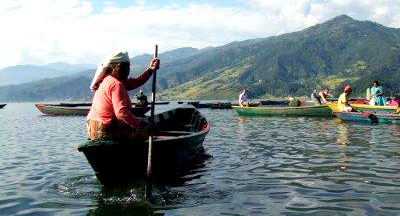
Arrive at Pokhara Hotel and rest a while. The Fewa (or Phewa) Lake 1.5 kilometer long, second largest lake in Nepal, offers an excellent view of the mountains and their reflections on the lake. Many tours and trekking operators and hotels are located on the lakeside. One can easily find a place to sit back, relax and enjoy great meal while enjoying scenery here. You will also enjoy boating on the lake. World Peace Pagoda, a massive Buddhist stupa is situated on the top of a hill on the southern shore of Phewa Lake. Besides being a impressive sight in itself, theshrine is a great vantage
point which offers the spectacular views of the Annapurna range, Phewa Lake, and the Pokhara city. Overnight at Pokhara Hotel Day 4: Fly from Pokhara to Jomsom 2720m and then 4 hours trek to Kagbeni 2810m.
Today we will take an early morning flight from Pokhara to Jomsom, the administrative centre for the Mustang district of Nepal. En-route we fly between Annapurna I and Dhaulagiri. We will meet our porters in Jomsom and trek to Kagbeni, which is situated at the confluence of the Jhong Khola (river) and the Kali Gandaki River.
Overnight stay in tents.
Day 5: Trek from Kagbeni to Chele 3050m. 7 hours trek.
Today we will take an early morning flight from Pokhara to Jomsom, the administrative centre for the Mustang district of Nepal. En-route we fly between Annapurna I and Dhaulagiri. We will meet our porters in Jomsom and trek to Kagbeni, which is situated at the confluence of the Jhong Khola (river) and the Kali Gandaki River.
Overnight stay in tents.
Day 5: Trek from Kagbeni to Chele 3050m. 7 hours trek.

The trek to Chele heads north along the Kali Gandaki River. The trail goes up and down for two hours to avoid the many river crossings, and then climbs steeply to a plateau avoiding a vertical-walled bluff ahead. From here it is a gradual climb to Tangbe (4 hrs). The trail climbs to 3,100m and then drops steeply to the banks of the Kali Gandaki. We will walk along the river bed crossing to the western bank before making a small climb to Chele.
Overnight stay in tents.
Overnight stay in tents.
Day 6: Trek from Chele to Eklo Bhatti 3820m. 6 hours trek
Trek to Eklo Bhatti. The trail climbs to Taklam La Pass through plateaus and narrow stretches with views of Tilicho Peak, Yakawa Kang, Nilgiri and Damodar Danda. It then descends a little to the village of Samar, altogether three hours from Chele. Between Samar and Geling the trail remains over 3,700m, so the group should be well acclimatized to camp in between. The first campsite arrives after two hours of climbing (mostly gradual), but only provides camping for a few tents. Another camp ground with nicer prospects is just one hour further.
Overnight stay in tents.
Day 7: Trek from Eklo Bhatti to Ghami 3520m. 4 hours trek
Trek to Ghami. The trail gently climbs to the Yamda La passing teahouses, chortens and Tibetan-influenced villages, and crosses over a few other passes. The longer climb will be to Nyi Pass after lunch, the trail then steeply descends to Ghami.
Overnight stay in tents.
Day 8: Trek from Ghami to Tsarang 3560m. 4 hours trek
This is an easy trekking day to Tsarang. After crossing Ghame Khola below Ghame, the trail climbs to a plateau and passes beside a very long mani wall. From the end of the wall the trail heads east to Tsarang, gradually climbing and then descending.
Overnight stay in tents.
Day 9: Trek from Tsarang to Lomanthang 3810m. 5 hours trek
The trek to Lomangthang hosts magnificent views of Nilgiri, Tilicho, Annapurna I and Bhrikuti peak. The trail first descends to Tsarang Chu Canyon and then climbs steeply after crossing the river. Further the trail ascends gently to the 3,850m windy pass of Lo, from where you can see the Lomanthang Valley. While descending to Lomangthang, views of the walled city appear magnificent with its hills on the Tibetan Border.
Overnight stay in tents.
Day 10: Rest at Lomanthang
Explore the eastern valleys and the Nyphu and Gharphu Monasteries before returning to Lomangthang. This trip is 12km (5-6 hrs) round trip.
Overnight stay in tents.
Day 11: Lomanthang Tour
This will be another roundtrip day excursion to explore Namgyal, Tingkar and the valleys to the west (7km/4-5 hrs).
Overnight stay in tents.
Day 12: Trek from Lomanthang to Tsarang 3560m. 6 hours trek
On the return journey we can take a detour to visit the Lo Gekor Monastery.
Overnight stay in tents.
Day 13: Trek from Tsarang to Tangee 3240m. 6 hours trek
After an hour's walk from Tsarang, Kaligandaki is crossed at about 3,170m. The crossing point is at the junction of the Kali Gandaki and Dhechyang Khola. The trail then heads south over a stony plain towards the valley of Tangee Khola and eventually climbs away from to the fields of Tangee.
Overnight stay in tents.
Day 14: Trek from Tangee to Tetang 3040m. 10 hours trek
A long trek to Tetang. The trail climbs down to the Tangee Khola and crosses a bridge, before coming over a ridge and descending to the wide stony plain of Yak Khola. A steep climb comes one hour out of Tangee. The summit (4,050m/13,325ft) is reached after four hours from the camp. As the trail comes over a few passes, the view is stunning. The trail is steep and rough with a lot of loose stone.
Overnight stay in tents.
Day 15: Trek from Tetang to Kagbeni 2810m. 6 hours trek
Trek back to Kagbeni, where we spent our first night on trek.
Overnight stay in tents.
Day 16: Trek from Kagbeni to Jomsom 2720m. 4 hours trek
Trek to Jomsom. We will celebrate with our crew in the evening, before departing the next day. Overnight stay in teahouse.
Day 17: Fly for Jomsom to Pokhara.
Transfer to the hotel. Free time for individual activities. Overnight at hotel.
Day 18: After breakfast full day sightseeing by private vehicle.
Trek to Eklo Bhatti. The trail climbs to Taklam La Pass through plateaus and narrow stretches with views of Tilicho Peak, Yakawa Kang, Nilgiri and Damodar Danda. It then descends a little to the village of Samar, altogether three hours from Chele. Between Samar and Geling the trail remains over 3,700m, so the group should be well acclimatized to camp in between. The first campsite arrives after two hours of climbing (mostly gradual), but only provides camping for a few tents. Another camp ground with nicer prospects is just one hour further.
Overnight stay in tents.
Day 7: Trek from Eklo Bhatti to Ghami 3520m. 4 hours trek
Trek to Ghami. The trail gently climbs to the Yamda La passing teahouses, chortens and Tibetan-influenced villages, and crosses over a few other passes. The longer climb will be to Nyi Pass after lunch, the trail then steeply descends to Ghami.
Overnight stay in tents.
Day 8: Trek from Ghami to Tsarang 3560m. 4 hours trek
This is an easy trekking day to Tsarang. After crossing Ghame Khola below Ghame, the trail climbs to a plateau and passes beside a very long mani wall. From the end of the wall the trail heads east to Tsarang, gradually climbing and then descending.
Overnight stay in tents.
Day 9: Trek from Tsarang to Lomanthang 3810m. 5 hours trek
The trek to Lomangthang hosts magnificent views of Nilgiri, Tilicho, Annapurna I and Bhrikuti peak. The trail first descends to Tsarang Chu Canyon and then climbs steeply after crossing the river. Further the trail ascends gently to the 3,850m windy pass of Lo, from where you can see the Lomanthang Valley. While descending to Lomangthang, views of the walled city appear magnificent with its hills on the Tibetan Border.
Overnight stay in tents.
Day 10: Rest at Lomanthang
Explore the eastern valleys and the Nyphu and Gharphu Monasteries before returning to Lomangthang. This trip is 12km (5-6 hrs) round trip.
Overnight stay in tents.
Day 11: Lomanthang Tour
This will be another roundtrip day excursion to explore Namgyal, Tingkar and the valleys to the west (7km/4-5 hrs).
Overnight stay in tents.
Day 12: Trek from Lomanthang to Tsarang 3560m. 6 hours trek
On the return journey we can take a detour to visit the Lo Gekor Monastery.
Overnight stay in tents.
Day 13: Trek from Tsarang to Tangee 3240m. 6 hours trek
After an hour's walk from Tsarang, Kaligandaki is crossed at about 3,170m. The crossing point is at the junction of the Kali Gandaki and Dhechyang Khola. The trail then heads south over a stony plain towards the valley of Tangee Khola and eventually climbs away from to the fields of Tangee.
Overnight stay in tents.
Day 14: Trek from Tangee to Tetang 3040m. 10 hours trek
A long trek to Tetang. The trail climbs down to the Tangee Khola and crosses a bridge, before coming over a ridge and descending to the wide stony plain of Yak Khola. A steep climb comes one hour out of Tangee. The summit (4,050m/13,325ft) is reached after four hours from the camp. As the trail comes over a few passes, the view is stunning. The trail is steep and rough with a lot of loose stone.
Overnight stay in tents.
Day 15: Trek from Tetang to Kagbeni 2810m. 6 hours trek
Trek back to Kagbeni, where we spent our first night on trek.
Overnight stay in tents.
Day 16: Trek from Kagbeni to Jomsom 2720m. 4 hours trek
Trek to Jomsom. We will celebrate with our crew in the evening, before departing the next day. Overnight stay in teahouse.
Day 17: Fly for Jomsom to Pokhara.
Transfer to the hotel. Free time for individual activities. Overnight at hotel.
Day 18: After breakfast full day sightseeing by private vehicle.

Visit Mahendra cave, Seti Bridge and Bindabasani Temple. We will take you to visit Davids Fall, Guptesyar Mahadev Temple. Davis Fall an unique waterfall that lies 2 Km from central Pokhara City. The water fall directly goes into a deep and narrow canal with no ends. It is believed that this deadly waterfall took the life of a tourist named David, who fell down into the canal and was never found, and hence the name David waterfall, named in his memory by the people of Pokhara. This place has many nick names like Davy's Fall, David's Fall or Davis's Fall, all mean the same thing.
After visiting the above mentioned places we will come back to hotel and have lunch there. After lunch we will take you to visit Intl Mountain Museum, Regional
After visiting the above mentioned places we will come back to hotel and have lunch there. After lunch we will take you to visit Intl Mountain Museum, Regional
Museum, Super Market and Lake Side Market and evening boating at Fewa Lake.
Overnight in Hotel.
Day 19: After breakfast departure to Kathmandu. Arrive at Kathmandu.
Overnight at hotel.
Day 20: Free time until departure to airport for your forward destination.
Tour End.
performed by Manang Holiday Travels & Tours
Ask for price info@crazy-travel.com
Overnight in Hotel.
Day 19: After breakfast departure to Kathmandu. Arrive at Kathmandu.
Overnight at hotel.
Day 20: Free time until departure to airport for your forward destination.
Tour End.
performed by Manang Holiday Travels & Tours
Ask for price info@crazy-travel.com


